Genome-wide analysis of the hypoxia-related DNA methylation-driven genes in lung adenocarcinoma progression
- PMID: 32031203
- PMCID: PMC7033312
- DOI: 10.1042/BSR20194200
Genome-wide analysis of the hypoxia-related DNA methylation-driven genes in lung adenocarcinoma progression
Abstract
Lung adenocarcinoma (LUAD) is a common type of lung cancer with high incidence and poor prognosis. Hypoxia and DNA methylation play important regulatory roles in cancer progression. The purpose of the present study was to explore the relationship between hypoxia and DNA methylation, and to identify key genes for hypoxia-regulated LUAD progression. Hypoxia score (HS) was calculated using the GSVA algorithm. Gene Ontology (GO), Kyoto Encyclopedia of Genes and Genomes (KEGG) pathway enrichment and protein-protein interaction (PPI) analysis were performed using clusterProfile package, STRING database and Cytoscape software. Kaplan-Meier curves of overall survival (OS) and disease-free survival (DFS) were drawn using R software. Smoking status and cancer stages were significantly associated with LUAD hypoxia, and hypoxia is a poor prognostic factor for LUAD. Compared with HS-low group, 1803 aberrantly methylated DEGs were identified in HS-high group. KEGG analysis showed that the 1803 genes were enriched in the metabolic pathways associated with hypoxia stress, angiogenesis and cancer progression. FAM20C, MYLIP and COL7A1 were identified as the hypoxia-related key genes in LUAD progression, which were regulated by DNA methylation. Hypoxia in LUAD tumor cells led to changes in DNA methylation patterns. In-depth study of the relationship between hypoxia and DNA methylation is helpful to elucidate the mechanism of tumorigenesis, and provides new ideas for LUAD treatment.
Keywords: DNA methylation; Hypoxia; Hypoxia-related gene; Lung adenocarcinoma.
© 2020 The Author(s).
Conflict of interest statement
The authors declare that there are no competing interests associated with the manuscript.
All relevant data are contained within the paper. Additional information can be obtained by contacting Dr Zhe Liu (zheliu_lza@163.com).
Figures
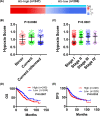
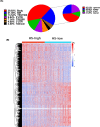
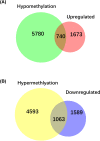
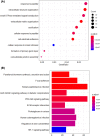

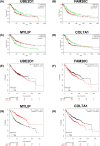



Similar articles
-
Predictions of the dysregulated competing endogenous RNA signature involved in the progression of human lung adenocarcinoma.Cancer Biomark. 2020;29(3):399-416. doi: 10.3233/CBM-200133. Cancer Biomark. 2020. PMID: 32741804
-
Analysis of genes associated with prognosis of lung adenocarcinoma based on GEO and TCGA databases.Medicine (Baltimore). 2020 May;99(19):e20183. doi: 10.1097/MD.0000000000020183. Medicine (Baltimore). 2020. PMID: 32384511 Free PMC article.
-
Comprehensive analysis of TPX2-related ceRNA network as prognostic biomarkers in lung adenocarcinoma.Int J Med Sci. 2020 Sep 1;17(16):2427-2439. doi: 10.7150/ijms.49053. eCollection 2020. Int J Med Sci. 2020. PMID: 33029085 Free PMC article.
-
Identification of prognostic values of the transcription factor-CpG-gene triplets in lung adenocarcinoma: A narrative review.Medicine (Baltimore). 2022 Dec 16;101(50):e32045. doi: 10.1097/MD.0000000000032045. Medicine (Baltimore). 2022. PMID: 36550923 Free PMC article. Review.
-
The roles of MASPIN expression and subcellular localization in non-small cell lung cancer.Biosci Rep. 2020 May 29;40(5):BSR20200743. doi: 10.1042/BSR20200743. Biosci Rep. 2020. PMID: 32391558 Free PMC article.
Cited by
-
Comprehensive analysis of transcriptome characteristics and identification of TLK2 as a potential biomarker in dermatofibrosarcoma protuberans.Front Genet. 2022 Sep 5;13:926282. doi: 10.3389/fgene.2022.926282. eCollection 2022. Front Genet. 2022. PMID: 36134026 Free PMC article.
-
From biomineralization to tumorogenesis-the expanding insight of the physiological and pathological roles of Fam20C.Biosci Rep. 2021 May 28;41(5):BSR20210040. doi: 10.1042/BSR20210040. Biosci Rep. 2021. PMID: 33942849 Free PMC article.
-
Feature screening for survival trait with application to TCGA high-dimensional genomic data.PeerJ. 2022 Mar 10;10:e13098. doi: 10.7717/peerj.13098. eCollection 2022. PeerJ. 2022. PMID: 35291482 Free PMC article.
-
Hypoxia in Lung Cancer Management: A Translational Approach.Cancers (Basel). 2021 Jul 8;13(14):3421. doi: 10.3390/cancers13143421. Cancers (Basel). 2021. PMID: 34298636 Free PMC article. Review.
-
Establishing a metastasis-related diagnosis and prognosis model for lung adenocarcinoma through CRISPR library and TCGA database.J Cancer Res Clin Oncol. 2023 Feb;149(2):885-899. doi: 10.1007/s00432-022-04495-z. Epub 2022 Dec 27. J Cancer Res Clin Oncol. 2023. PMID: 36574046 Free PMC article.
References
MeSH terms
Substances
LinkOut - more resources
Full Text Sources
Medical

